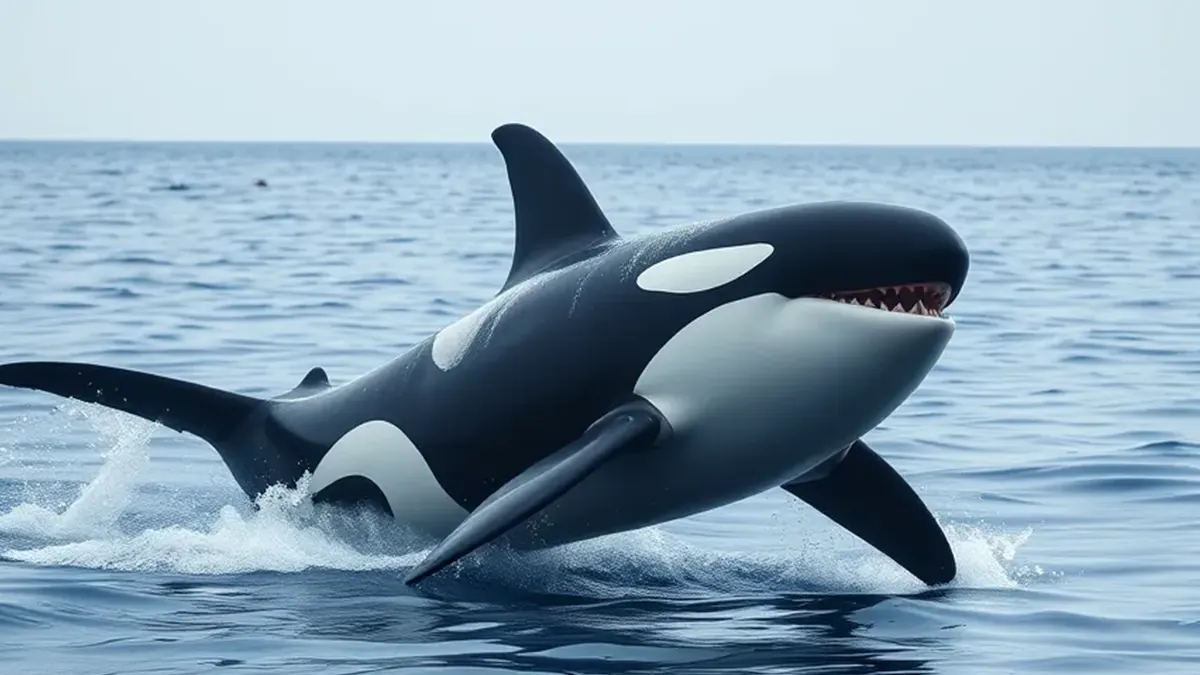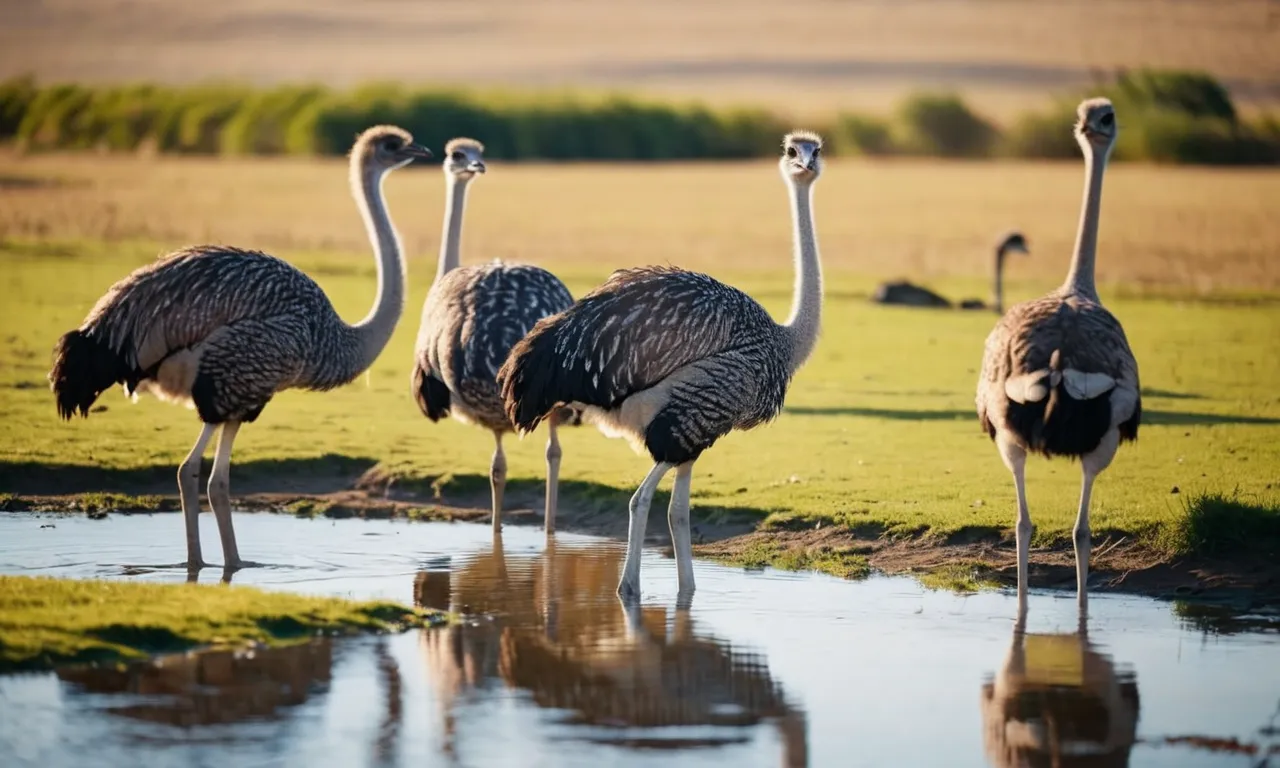For many animals, swimming comes as naturally as walking or running. Aquatic creatures like fish, whales, and sharks are born knowing how to swim, using their tails and flippers to propel themselves through the water. But what about those animals that never quite got the hang of it?
Believe it or not, there are actually quite a few animals that can’t swim at all.
If you’re short on time, here’s a quick answer to your question: Hippos, camels, giraffes, gorillas, and chimpanzees are examples of large mammals that are unable to swim due to their anatomy and evolution in non-aquatic environments.
In this comprehensive guide, we’ll take a deep dive into animals that can’t swim, looking at their evolutionary history and anatomical limitations. We’ll also bust some common myths and look at what these animals do when encountering water.
Read on to learn all about these terrestrial creatures and why swimming just wasn’t in the cards for them.
Large Mammals That Can’t Swim
Hippopotamus
You may be surprised to learn that despite their massive size and semi-aquatic lifestyle, hippos actually can’t swim. Their bodies are too dense and heavy to float. Instead, they simply walk along the riverbed or lake floor.
Hippos can hold their breath underwater for up to 5 minutes before resurfacing. While they spend lots of time in water to regulate their temperature and hide from predators, they don’t have the buoyancy or leg coordination to properly swim.
Camels
Camels are another shockingly non-buoyant animal. As desert dwellers, camels don’t often encounter bodies of water. And with their unusual physique featuring long legs and large humps, camels would likely tip over if they tried to swim.
Their hooves are designed for walking on sand rather than paddling. So while camels can wade through shallow water if necessary, they cannot truly swim.
Giraffes
Towering giraffes face the same issues as camels when it comes to swimming. Their incredibly long legs make coordination and buoyancy nearly impossible. That’s why giraffes tend to just avoid water altogether if they can.
In times of drought, giraffes have been observed wading through mud or small streams. But water that is too deep can easily lead to drowning. Sadly, some young giraffes do perish this way during the rainy season in Africa.
Gorillas and Chimpanzees
Our closest primate relatives also lack swimming skills. Species like gorillas and chimpanzees may wade into bodies of water but quickly retreat back to dry land. Researchers believe that they likely did not evolve adaptations for swimming since they have relatively few predators on land.
Additionally, their dense muscle mass causes them to sink. There have been a few anecdotal reports of some chimps using a dog paddle stroke to maneuver across small rivers. But most apes sensibly avoid going in too deep.
Evolutionary Explanations
Aquatic vs. Terrestrial Environments
Animals that live in water versus on land face very different evolutionary pressures. Aquatic environments select for traits like streamlining, webbed appendages for swimming, gills or other adaptations for underwater breathing, and more buoyant body types.
In contrast, terrestrial species tend to have adaptations for moving on solid ground, breathing air, and supporting their body mass against gravity.
For example, otters have webbed feet and dense fur that traps air close to their bodies, allowing them to swim and float well. But a tiger has powerful leg muscles and paws with claws and pads that provide traction for running and grasping prey on land.
So each habitat drives the evolution of different anatomies.
Anatomical Adaptations
Species that are more adapted for a terrestrial life may lack some of the traits needed for entering water and swimming effectively:
- Little to no webbing between digits
- Less buoyant/denser bodies
- Limited flexibility in limb joints
- A lack of propulsion mechanisms like a tail or webbed feet
Additionally, some terrestrial animals have physical attributes that seem disadvantageous for aquatic mobility, such as a sloth’s long claws or a deer’s slender legs. Without the proper anatomical features that provide thrust and keep the head above water, land animals struggle to traverse and steer through water effectively.
Differences Between Species
There is variation in swimming capability even among terrestrial mammals. For example, here is a comparison of three land animals:
| Dogs | Cats | Elephants | |
|---|---|---|---|
| Swimming Ability | Moderate – Good | Poor | Very Poor |
| Leg Muscles | Stronger | Weaker | Strong, but heavy |
Dogs tend to have an easier time swimming than cats and elephants. Their anatomy features greater leg strength to paddle water more easily. Cats dislike water due to weaker musculature and lack of propulsion.
Lastly, elephants struggle as their heavy bodies make buoyancy and balance extremely difficult even though their legs are quite powerful.
For more details, see this WebMD slideshow comparing pet species and their swimming capabilities based on physiology and behavior.
What These Animals Do Around Water
Avoidance Behaviors
Many terrestrial animals that can’t swim or float tend to avoid getting near water bodies like lakes, rivers or oceans where possible according to a National Geographic report. Land creatures like rabbits, guinea pigs, chinchillas, hamsters, mice, rats, gerbils, hogs, llamas, horses, donkeys and mule deer often exhibit anxiety and signs of stress when placed in watery environments.
They will try to run or jump away from the threat of drowning. For example, research shows pet guinea pigs may refuse to eat or drink when their water bottles leak and make them wet. Wild species tend to stay clear of rivers, lakes or wetlands altogether to eliminate drowning risks.
Panic Reactions
Terrestrial mammals with limited swimming capabilities like cats, tigers, leopards, lions, sheep, goats, and cattle display extreme panic when falling into deep water unexpectedly. They often paddle frantically with their legs, which quickly leads to exhaustion.
According to an article, domestic cats may start meowing loudly, hissing, clawing, and even biting when owners try giving them a bath. Wild felines like lions can tread water briefly using their powerful legs, but will ultimately sink if they can’t reach land quickly enough.
Hoofed animals also sink rapidly despite vigorous attempts to stay afloat.
Injury and Drowning Risks
The ASPCA reports that terrified land animals at risk of drowning frequently sustain injuries like lacerations, broken bones, and dislocated joints from hitting solid objects or surfaces in their frantic attempts to get out of the water.
Additionally, uncontrolled ingestion of water often leads to choking, coughing, vomiting, and aspiration pneumonia. Per 2018 statistics, over 5,000 cats and dogs combined tragically lose their lives annually from drowning incidents mostly in residential pools and hot tubs.
For wild species, drowning accounts for 2-50% of total mortality each year depending on the type habitat near water bodies.
| Animal | Average Drowning Mortality Rate |
|---|---|
| Deer | 2% |
| Moose | 5% |
| Rodents | 20% |
| Felines | 50% |
As evident from the table, smaller mammals tend to have higher risks of drowning if they accidentally fall into bodies of water. Larger ungulates like deer and moose can sometimes swim or wade briefly before becoming exhausted.
But overall, rapid rescue is critical for the survival of any land creature that lacks adaptations for an aquatic lifestyle.
Swimming Myths Debunked
Hippos Can’t Actually Swim
Contrary to popular belief, hippos are excellent swimmers! Their barrel-shaped bodies are perfectly adapted for spending long hours in the water. Although hippos can’t actually “swim” in the traditional sense, they are able to propel themselves through the water by pushing off the bottom with their strong legs.
Their webbed feet and short legs are ideal for powerful kicking motions underwater. Hippos can hold their breath for up to 5 minutes and have been recorded swimming underwater distances of over 30 feet before coming up for air.
So while they might look a bit silly bobbing around, hippos are amazingly graceful in the water!
Giraffes Don’t Mysteriously Drown
It’s a myth that giraffes are completely incapable of swimming and will drown if they end up in deep water. While giraffes aren’t naturally adapted for aquatic life like hippos, they can actually swim quite well for short distances if needed. Their long legs provide powerful propulsion in the water.
However, the extreme height and weight of giraffes makes swimming energetically costly for them. This means they tend to avoid deep water when possible, since the effort to swim across would quickly exhaust them.
There have been rare cases of giraffes drowning when trapped in flooding situations with no way to escape. But overall, it’s false to claim giraffes are mysteriously prone to drowning themselves – they simply prefer to stay on dry land!
Gorillas Don’t Really Know How to Swim
It was long assumed that gorillas couldn’t swim at all since they live in dense forests far from large bodies of water. But over the past few decades, researchers have discovered that gorillas are actually capable swimmers under the right conditions!
When placed in water, gorillas demonstrate a basic “doggy paddle” stroke that allows them to move through the water for short distances. However, since they rarely encounter water in the wild, swimming is not a natural behavior for gorillas.
Even gorillas raised in captivity show a strong aversion to entering water deeper than waist-high. While gorillas have the physical ability to swim if needed, their dense muscle and heavy builds are not well-suited for buoyancy.
This means they tire quickly and panic easily when swimming out of their depth. So the myth isn’t that gorillas can’t swim at all – just that they feel most comfortable with their feet firmly planted on the ground!
Conclusion
While swimming is second nature for many animals, some terrestrial species like hippos, camels, giraffes, gorillas and chimpanzees never adapted the ability. Their anatomy and evolution in non-aquatic environments made swimming difficult or impossible.
When encountering water, these animals tend to avoid it, react with panic, or risk injury and drowning. While popular myths persist about some species being able to swim, a look at the evidence proves otherwise.
The next time you visit a river, lake or zoo, take a moment to appreciate these land lovers who never quite got the hang of swimming!





Thank you for your sharing. I am worried that I lack creative ideas. It is your article that makes me full of hope. Thank you. But, I have a question, can you help me?
Your article helped me a lot, is there any more related content? Thanks!
Thank you for your sharing. I am worried that I lack creative ideas. It is your article that makes me full of hope. Thank you. But, I have a question, can you help me?
Can you be more specific about the content of your article? After reading it, I still have some doubts. Hope you can help me.
Thanks for sharing. I read many of your blog posts, cool, your blog is very good.
Can you be more specific about the content of your article? After reading it, I still have some doubts. Hope you can help me.
I don’t think the title of your article matches the content lol. Just kidding, mainly because I had some doubts after reading the article.
Thanks for sharing. I read many of your blog posts, cool, your blog is very good.
Can you be more specific about the content of your article? After reading it, I still have some doubts. Hope you can help me.
Your point of view caught my eye and was very interesting. Thanks. I have a question for you.
Thanks for sharing. I read many of your blog posts, cool, your blog is very good.
Thanks for sharing. I read many of your blog posts, cool, your blog is very good.
Can you be more specific about the content of your article? After reading it, I still have some doubts. Hope you can help me.
Your point of view caught my eye and was very interesting. Thanks. I have a question for you. https://accounts.binance.com/ar-BH/register?ref=V2H9AFPY
I don’t think the title of your article matches the content lol. Just kidding, mainly because I had some doubts after reading the article.
Can you be more specific about the content of your article? After reading it, I still have some doubts. Hope you can help me.
Can you be more specific about the content of your article? After reading it, I still have some doubts. Hope you can help me.
Your article helped me a lot, is there any more related content? Thanks!
Your article helped me a lot, is there any more related content? Thanks! https://www.binance.com/join?ref=P9L9FQKY
Thanks for sharing. I read many of your blog posts, cool, your blog is very good.
Thank you for your sharing. I am worried that I lack creative ideas. It is your article that makes me full of hope. Thank you. But, I have a question, can you help me?
I don’t think the title of your article matches the content lol. Just kidding, mainly because I had some doubts after reading the article. https://www.binance.com/hu/register?ref=FIHEGIZ8
I don’t think the title of your article matches the content lol. Just kidding, mainly because I had some doubts after reading the article. https://accounts.binance.com/register?ref=P9L9FQKY
I don’t think the title of your article matches the content lol. Just kidding, mainly because I had some doubts after reading the article.
Thank you for your sharing. I am worried that I lack creative ideas. It is your article that makes me full of hope. Thank you. But, I have a question, can you help me?
Thank you for your sharing. I am worried that I lack creative ideas. It is your article that makes me full of hope. Thank you. But, I have a question, can you help me?
Thank you for your sharing. I am worried that I lack creative ideas. It is your article that makes me full of hope. Thank you. But, I have a question, can you help me?
Can you be more specific about the content of your article? After reading it, I still have some doubts. Hope you can help me.
Your point of view caught my eye and was very interesting. Thanks. I have a question for you.
Your point of view caught my eye and was very interesting. Thanks. I have a question for you.
Your point of view caught my eye and was very interesting. Thanks. I have a question for you.
Your point of view caught my eye and was very interesting. Thanks. I have a question for you.
Thanks for sharing. I read many of your blog posts, cool, your blog is very good.
Thanks for sharing. I read many of your blog posts, cool, your blog is very good.
I don’t think the title of your article matches the content lol. Just kidding, mainly because I had some doubts after reading the article. https://accounts.binance.info/en/register?ref=JHQQKNKN
Can you be more specific about the content of your article? After reading it, I still have some doubts. Hope you can help me.
Can you be more specific about the content of your article? After reading it, I still have some doubts. Hope you can help me.
Can you be more specific about the content of your article? After reading it, I still have some doubts. Hope you can help me.
Can you be more specific about the content of your article? After reading it, I still have some doubts. Hope you can help me.
Your point of view caught my eye and was very interesting. Thanks. I have a question for you.
Can you be more specific about the content of your article? After reading it, I still have some doubts. Hope you can help me.
Your article helped me a lot, is there any more related content? Thanks!
I don’t think the title of your article matches the content lol. Just kidding, mainly because I had some doubts after reading the article.
Thanks for sharing. I read many of your blog posts, cool, your blog is very good.
Thanks for sharing. I read many of your blog posts, cool, your blog is very good.
Thanks for sharing. I read many of your blog posts, cool, your blog is very good.
I don’t think the title of your article matches the content lol. Just kidding, mainly because I had some doubts after reading the article.
Your point of view caught my eye and was very interesting. Thanks. I have a question for you.
Can you be more specific about the content of your article? After reading it, I still have some doubts. Hope you can help me.
Thanks for sharing. I read many of your blog posts, cool, your blog is very good.
Thank you for your sharing. I am worried that I lack creative ideas. It is your article that makes me full of hope. Thank you. But, I have a question, can you help me?
Your point of view caught my eye and was very interesting. Thanks. I have a question for you.
Your article helped me a lot, is there any more related content? Thanks!
Thank you for your sharing. I am worried that I lack creative ideas. It is your article that makes me full of hope. Thank you. But, I have a question, can you help me?
Your point of view caught my eye and was very interesting. Thanks. I have a question for you.
Can you be more specific about the content of your article? After reading it, I still have some doubts. Hope you can help me.
I don’t think the title of your article matches the content lol. Just kidding, mainly because I had some doubts after reading the article.
Your article helped me a lot, is there any more related content? Thanks!
I don’t think the title of your article matches the content lol. Just kidding, mainly because I had some doubts after reading the article. https://www.binance.info/sv/join?ref=PORL8W0Z
Thank you for your sharing. I am worried that I lack creative ideas. It is your article that makes me full of hope. Thank you. But, I have a question, can you help me?
Thanks for sharing. I read many of your blog posts, cool, your blog is very good.
I don’t think the title of your article matches the content lol. Just kidding, mainly because I had some doubts after reading the article.
Can you be more specific about the content of your article? After reading it, I still have some doubts. Hope you can help me.
Thanks for sharing. I read many of your blog posts, cool, your blog is very good.
Your article helped me a lot, is there any more related content? Thanks!
Thanks for sharing. I read many of your blog posts, cool, your blog is very good.
Your point of view caught my eye and was very interesting. Thanks. I have a question for you.
Your point of view caught my eye and was very interesting. Thanks. I have a question for you.
Your point of view caught my eye and was very interesting. Thanks. I have a question for you.
Thanks for sharing. I read many of your blog posts, cool, your blog is very good.
Can you be more specific about the content of your article? After reading it, I still have some doubts. Hope you can help me.
Thank you for your sharing. I am worried that I lack creative ideas. It is your article that makes me full of hope. Thank you. But, I have a question, can you help me?
Your point of view caught my eye and was very interesting. Thanks. I have a question for you.
Can you be more specific about the content of your article? After reading it, I still have some doubts. Hope you can help me.
Your point of view caught my eye and was very interesting. Thanks. I have a question for you.
Thanks for sharing. I read many of your blog posts, cool, your blog is very good.
Thank you for your sharing. I am worried that I lack creative ideas. It is your article that makes me full of hope. Thank you. But, I have a question, can you help me?
Thanks for sharing. I read many of your blog posts, cool, your blog is very good.
Thank you for your sharing. I am worried that I lack creative ideas. It is your article that makes me full of hope. Thank you. But, I have a question, can you help me?